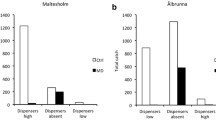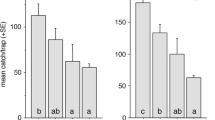Abstract
Microcapsules of sex pheromone of the diamondback moth (DBM), Plutella xylostella (Lepidoptera: Plutellidae) were synthesized through complex coacervation using gelatin and gum arabic as wall-forming materials. The encapsulated pheromone released from these microcapsules into the air was monitored over six weeks in the field. Results of a field trial show that the attractiveness of microcapsules was superior to that of rubber septa loaded with the same amount of pheromone. The mating disruption efficiency of the pheromone treatment was estimated through comparing numbers of moths captured in pheromone-baited traps placed in pheromone treatment fields and pesticide treatment fields. The estimated mating disruption efficiency of the pheromone treatments ranged from 76.94% to 98.67% during the season. This study shows that pheromone microcapsules might provide a new method for P. xylostella control.
Similar content being viewed by others
References
Wang X P, Le V T, Fang Y L, et al. Trap affect on the capture of Plutella xylostella (Lepidoptera: Plutellidae) with sex pheromone lures in cabbage fields in Vietnam. Appl Entomol Zool, 2004, 39(2): 303–309
Baker P B, Shelton A M, Andale J T. Monitoring of diamondback moth (Lepidoptera: Plutellidae) in cabbage with pheromones. J Econ Entomol, 1982, 75: 1025–1028
Shirai Y, Nakamura A. Relationship between the numbers of wild males captured by sex pheromone trap and the population density estimated from a mark-recapture study in the diamondback moth, Plutella xylostella (L.) (Lepidoptera: Plutellidae). Appl Entomol Zool, 1995, 30: 543–549
Ronald T. Relationship between the number of males captured by sex pheromone traps and wild population density in the field. J Entomol Sci, 1997, 22: 120–137
Reddy G V, Guerrero A. Optimum timing of insecticide applications against diamondback moth Plutella xylostella in cole crops using threshold catches in sex pheromone traps. Manag Sci Pest, 2001, 57(1): 90–94
Chisholm M D, Underhil E W, Steck W F. Field trapping of the diamondback moth (Lepidoptera: Plutellidae) using synthetic sex attractants. Environ Entomol, 1979, 8: 516–518
Mclaughlin J R, Mitchell E R, Kirsch P A. Mating disruption of DBM in cabbage: Reduction of mating and suppression of larval populations. J Econ Entomol, 1994, 97: 1198–1204
Reddy G V P, Urs K C D. Mass trapping of diamondback moth Plutella xylostella in cabbage fields using synthetic sex pheromone. Int Pest Cont, 1997, 39: 125–126
Reddy G V P, Guerrero A. Pheromone-based integrated pest management to control the diamondback moth Plutella xylostella in cabbage fields, Pest Manag Sci, 2000, 56: 882–888
Chisholm M D, Underhill E W, Palaniswamy P, et al. Orientation disruption of male diamondback moths (Lepidoptera: Plutellidae) to traps baited with synthetic chemicals or female moths in small field plots. J Econ Entomol, 1984, 77: 157–160
Chow Y S. Disruption effect of the synthetic sex pheromone and its analogues on diamondback moth. In: Talker N S, ed. Management of Diamondback Moth and Other Crucifer Pests. Proceedings of the Second International Workshop. Taiwan, China: Asian Vegetable Research and Development Center (AVRDC) Publication, 1992. 105–108
Nemoto H, Yano E, Kiritani K. Pheromonal control of diamondback moth in the management of crufier pests. In: Talker N S, ed. Management of Diamondback Moth and Other Crucifer Pests. Proceedings of the Second International Workshop. Taiwan, China: Asian Vegetable Research and Development Center (AVRDC) Publication, 1992. 91–97
Ohbayashi N, Shimizu K, Nagata K. Control of diamondback moth using synthetic sex pheromones. In: Talker N S, ed. Management of Diamondback Moth and Other Crucifer Pests. Proceedings of the Second International Workshop. Taiwan, China: Asian Vegetable Research and Development Center (AVRDC) Publication, 1992. 99–104
Ohno T, Asayama T, Ichikawa K. Evaluation of communication disruption method using synthetic sex pheromone to suppress diamondback moth infestations. In: Talker N S, ed. Management of Diamondback Moth and Other Crucifer Pests. Proceedings of the Second International Workshop. Taiwan, China: Asian Vegetable Research and Development Center (AVRDC) Publication, 1992. 109–114
Chisholm M D. Field trapping of the diamondback moth (Lepidoptera: Plutellidae) using synthetic sex attractants. Environ Entomol, 1979, (8): 516–518
Chisholm M D, Steck W F, Underhill E W, et al. Field trapping of diamondback moth Plutella xylostella using an improved four-component sex attractant blend. J Chem Ecol, 1983, 9(1): 113–119
Schroeder R M, Shelton A M, Ferguson C S, et al. Application of synthetic sex pheromone for management of diamondback moth, Pluttella xylostella, in cabbage. Entomol Exp Appl, 2000, 94: 243–248
Kawasaki K. Effects of ratio and amount of the two sex pheromonal components of the diamondback moth on male behavioral response. Appl Ent Zool, 1984, 19(4): 436–442
Testu A. Electroantennogram activities of sex pheromone analogues and their synergistic effect on diamondback moth in the field attraction. Appl Ent Zool, 1979, 14(3): 362–364
Tamaki Y, Kawasaki K, Yamada H, et al. (Z)-11-hexadecenal and (Z)-11-hexadecenyl acetate: sex pheromone components of the diamondback moth (Lepidoptera: Plutellidae). Appl Entomol Zool, 1977, 12(2): 208–210
Liu X, Macaulay E D M, Pickett J A. Propheromones that release pheromonal carbonyl compounds in light. J Chem Ecol, 1984, 10(5): 809–822
Shulkin A, Stöver H D H. Polymer microcapsules by interfacial polyaddition between styrene-maleic anhydride copolymers and amines. J Memb Sci, 2002, 209: 421–432
Caro J H, Freeman H P, Brower D L, et al. Comparative distribution and persistence of disparlure in woodland air after aerial application of three controlled-release formulations. J Chem Ecol, 1981, 7(5): 867–880
Sanders C J, Weatherston I. Sex pheromone of the eastern spruce budworm: Optimum blend of trans-and cis-11-tetradecenal. Can Entomol, 1976, 108: 1285–1290
Campion D G, McVeigh L J, Hunter-Jones P, et al. Evaluation of microencapsulated formulations of pheromone components of the Egyptian cotton leafworm Spodoptera littoralis. In: Mitchell E R, ed. Management of Insect Pests with Semiochemicals: Concepts and Practice. New York: Plenum Press, 1981. 253–265
Hall D R, Marrs G J. Microcapsules. In: Jutsum A R, Gordon R F S, eds. Insect Pheromones in Plant Protection. New York: John Wiley & Sons Ltd, 1989. 219–220
Xu S Y, Zhang X M, Xia S Q, et al. Microcapsule Technology-Theory and Application (in Chinese). Beijing: Chemical Industry Press, 2006. 149–150
Li Y H, Fan M W, Bian Z, et al. Chitosan-DNA microparticles as mucosal delivery system: Synthesis, characterization and release in vitro. Chin Med J, 2005, 118(11): 936–941
Hall D R, Nesbitt B F, Marrs G J, et al. Development of microencapsulated pheromone formulations. In: Leonhardt B A, Beroza M, eds. Insect Pheromone Technology: Chemistry and Applications. New York: American Chemical Society, 1981. 131–143
Author information
Authors and Affiliations
Corresponding author
Additional information
Supported by the Innovation Program of the Chinese Academy of Sciences (Grant No. KSCX2-1-02)
About this article
Cite this article
Chen, Z., Fang, Y. & Zhang, Z. Synthesis and assessment of attractiveness and mating disruption efficacy of sex pheromone microcapsules for the diamondback moth, Plutella xylostella (L.). CHINESE SCI BULL 52, 1365–1371 (2007). https://doi.org/10.1007/s11434-007-0209-x
Received:
Accepted:
Issue Date:
DOI: https://doi.org/10.1007/s11434-007-0209-x




